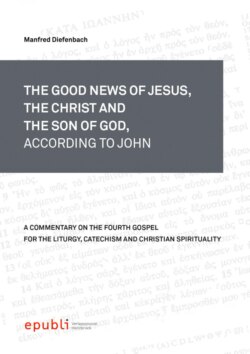Читать книгу THE GOOD NEWS OF JESUS, THE CHRIST AND THE SON OF GOD, ACCORDING TO JOHN - Manfred Diefenbach - Страница 8
На сайте Литреса книга снята с продажи.
Chapter 1
ОглавлениеThe so-called “Prologue” – or “preamble” respectively “proem”9 – as the “preface”10 to the Fourth Gospel is similar to a kind of musical overture and emphasized with the words (vv. 1a, 2: “in the beginning”) in allusion to Genesis 1:1a (LXX = Septuagint) as a “hymn”11/poem of the incarnate “Word” (in Greek “lógos” in vv. 1a, b, c, 14a) of God in “Jesus” (cf. vv. 14, 17). It has three parts (cf. vv. 1–5, 6–13, 14–1812). The first two strophes are connected with the keyword “light” (in Greek “phõs”) in verses 5a, 8a, b, 9a, b. In each of them, the first theme is the “Word” (cf. vv. 1–5, 14) and then the theme is the witness of John the Baptist (cf. vv. 6–8, 15) and then the decision/beliefs of the human beings for Jesus Christ as “God’s Word” (His acceptance) or against Him (His refusal). “Not” John the Baptist (cf. v. 813 [“the light”], v. 20 [“the Christ/Messiah”], v. 21 [“Elijah”] and v. 25 [“the prophet”]), but Jesus is the “true light” (v. 9).
The passage of 1:19–51 is structured with the help of the phrase “the next day” in verses 29, 35, 43. Verses 6–8 are a part of the prologue (cf. vv. 1–18). The keyword “witness” in verses 7a, b, 8b emphasizes in verse 19 the mission declaration of John the Baptist in the form of his juristic investigation by the Jewish Temple “police” from Jerusalem as a dialogue (cf. vv. 19–28). Between verses 6–8 and 19 the Fourth Evangelist meditates about (incarnate) Jesus as the light of the world (cf. vv. 9–18). He uses some verbs of the conversation in the context of the investigation between the Temple “police” of Jerusalem and John the Baptist with regard to John’s identity (cf. vv. 19–23) and his authority (cf. vv. 24–27): The verbs to “ask” in verses 19d, 21a, 25a and to “say” in verse 22a, d are used for the delegation from Jerusalem; however the Evangelist uses the two special terms of the jurisdiction to “confess” in verse 20a, c, to “deny” in verse 20b and the verbs to “answer” in verses 21g, 26a, to “say” in verses 21d, 26a as well as to “reply” in verse 23a in the view of John the Baptist. He answers four of five questions (cf. vv. 19d, 21a–b, d, 22; 25) in the negative (cf. vv. 20b, 21c, e, 26c, 27b). A comment by the Evangelist concludes the juristic hearing and it localizes John the Baptist’s ministry at the river Jordan near Bethany (cf. v. 28).
John 1:19–51 contains a list of witnesses to Jesus by John the Baptist to two of his disciples (cf. vv. 19–28, 29–34) and by Andrew to Simon (cf. vv. 40–42), one of his own disciples, who follows Jesus (cf. vv. 35–42) of “Nazareth” (v. 45), “the Lamb of God”14 (vv. 29, 36) as well as by Philip to Nathanael (cf. vv. 43–51) with the help of the phrase “the next day” in verses 29, 35, 43. After the call of His first two disciples (cf. vv. 35a–39c), a comment by the Evangelist (cf. vv. 39d–40) emphasizes the call of Simon Peter (cf. vv. 41–42) which differs from the synoptic versions of the call of His first disciples (cf. Mark 1:16–20; Matthew 4:18–22 in contrast to Luke 5:1–11).
Microstructure of John 1
